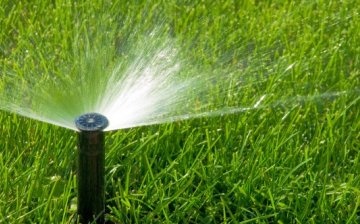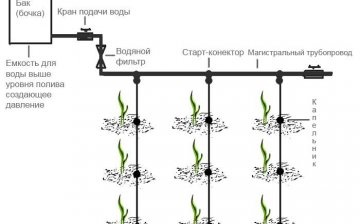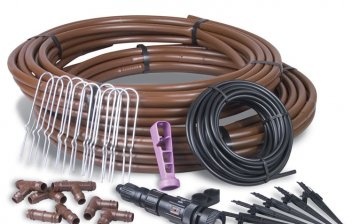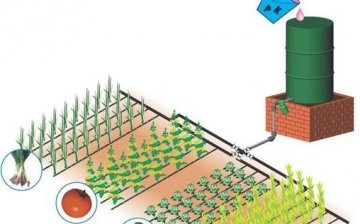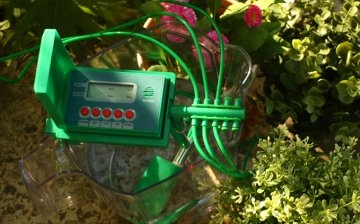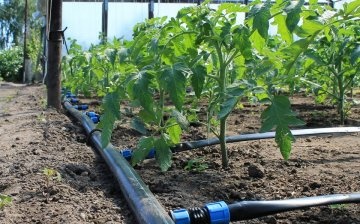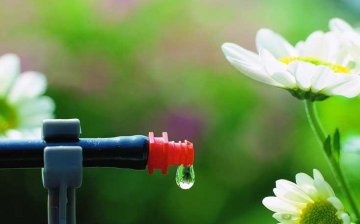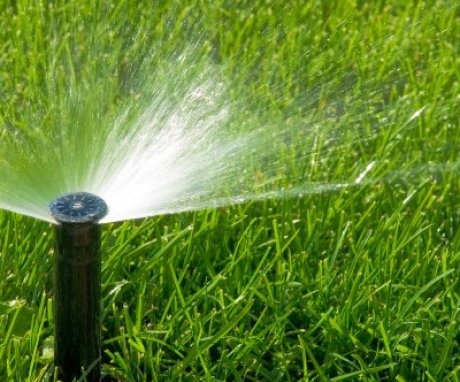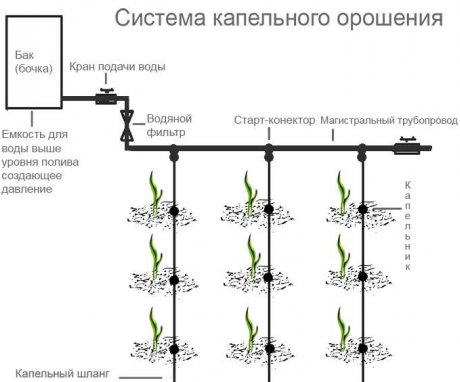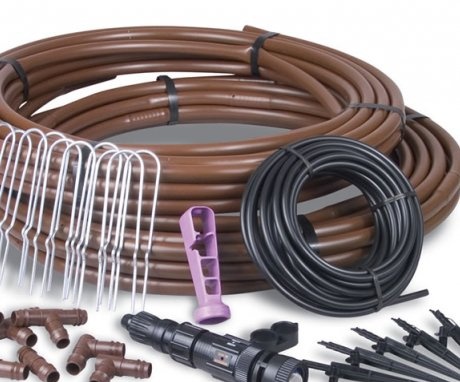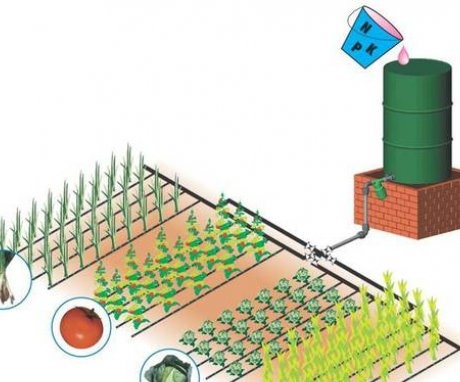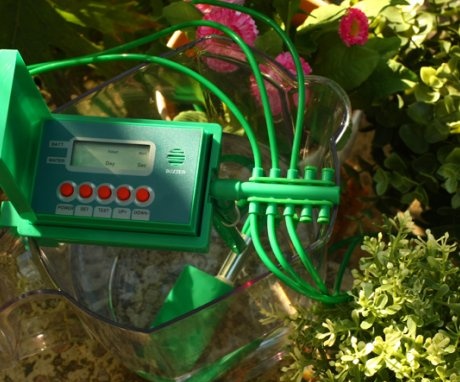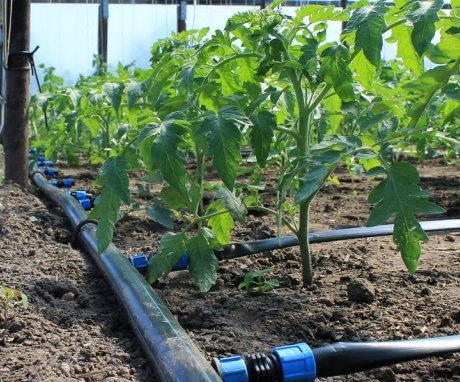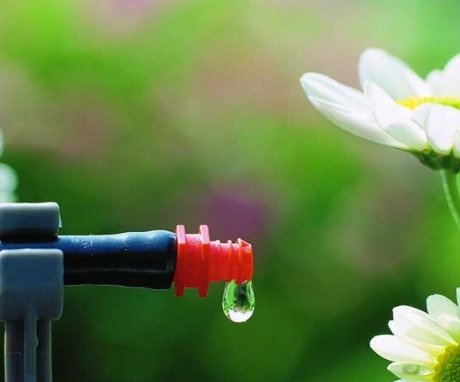Do-it-yourself automatic watering: types, materials and installation rules
Manual watering over time it becomes a very tedious and difficult job that takes up a lot of time every day. In addition, in summer cottages, all plots are often watered simultaneously, which leads to a drop in the water level in the system and an additional delay in irrigation time. The problem can be solved by arranging an automatic irrigation system: this is not a very difficult task, and it is quite possible to cope with it with very low costs. How to organize automatic watering with your own hands in the country?
Content:
- The main types of automatic irrigation
- Scheme and plan
- Materials (edit)
- Bandwidth calculation
- Choice of control system
- Installation of an automatic irrigation system
- A few tips for organizing watering
The main types of automatic irrigation
In the dacha and suburban economy, you can use several types of sprinklers that are suitable for different types of plants. They vary significantly in cost and installation complexity.
The most common types are:
- Classic static sprinklers. Water comes out of the outlet for a small irrigation radius, so they should only be used for small flower beds and lawns. They also have one more disadvantage: most of the water accumulates around the sprinkler itself.
- Rotary sprinklers. They rotate, ensuring the maximum spread of the vaults around them, while, due to a special nozzle, water is sprayed in small drops, and it will not damage the plants. The greater the head power, the wider the radius will be.
- Drip irrigation system. It supplies water to the root zone under the leaves of plants: this will save them from getting drops on the leaves and from the appearance of sunburn. Special droppers will allow a limited amount of water to be supplied to the roots to prevent rotting.
- Mist sprinklers. They break the flow of water into very small droplets, more like fog. Such irrigation systems are used mainly in greenhouses, they allow you to create and maintain a certain microclimate. It will be constantly humid in the greenhouse room, while such sprinklers will not allow the roots to become waterlogged.
When developing a scheme, you need to take into account where and what plants you expect grow... If it is more profitable for lawns to install rotary systems, then drip is preferable for beds watering etc. For each type of plant, it is desirable to create suitable conditions. so as not only not to harm, but also to get a good result.
Scheme and plan
The first stage of work on arranging an automatic system is drawing up a plan that takes into account the location of water intake points and green spaces. The easiest way to water your plants is using rubber hoses, but the water jet will constantly loosen the soil, which is additional tedious work.
A simpler and more effective solution is drip irrigation, for which sprinklers (sprinklers) are installed on the site.
It is advisable to start work on drawing up an automatic irrigation plan immediately when buying a plot before green spaces appear on it. However, if this was not done right away, you will have to build a plan in accordance with the already existing layout.
To work with the plan, you will need ordinary graph paper with markings. On it you need to draw the location of all important elements: a residential building, gazebos, outbuildings, barbecue, etc. In addition, the plan reflects the location pumping station and all green spaces that the system will water. If the site has not yet been planted, then you can first think over the irrigation system, under which it will be convenient to arrange flower beds and beds.
Ideally, the pumping station should be located in the central part of the site, this will allow the pipelines for supplying water to be laid at the same length, and the pressure in the entire system will be uniform. The number and location of sprinklers is determined by their range. If, for example, it is 25 meters, you need to draw on the plan the location of the sprinklers and the radius of their work in the idea of circles.
This will ensure a complete watering each zone, and one point will not get too much water.
The last stage of the design is the transfer of the plan from paper to the site. To do this, you must use a cord and pegs: they indicate all pipelines, and the pegs are installed where the sprinklers will stand. This will allow you to assess the correct location of the system.
Materials (edit)
A properly designed scheme will allow you to calculate how much materials will be required to install an irrigation system on the site. It includes the following main elements:
- Pipeline. For irrigation of the site, you can purchase ordinary plastic or metal-plastic pipes: they serve for a long time, do not corrode, and with their help you can provide a durable, workable system. The optimal material is low-pressure polyethylene, the cross-section of pipes near the pumping station should be larger than near the sprinklers.
- Pumping station with a set of filters. The pump power depends on the irrigated area, the calculation can be carried out using engineering tables that can be found on the network. The installation of filters is necessary, since a certain amount of sand and other impurities is always present in the water, and unfiltered water will quickly disable the system.
- Pressure regulators and solenoid valves. They will allow you to alternately start the sprinklers into operation. The controller will open and close the valves, and this will allow drip irrigation of different zones in turn.
- Sprinklers with the correct irrigation radius. The most common and affordable sprinkler is the rotary type - it will provide uniform watering by rotating.
In addition, to assemble the system, you will need to purchase connecting elements for the pipeline, as well as tools for laying pipes around the site. The larger it is, the more earthwork remains to be done, therefore, to speed up the process on a large site, it is better to invite assistants.
Bandwidth calculation
It is important to determine how many sprinklers can work at the same time; for this it is necessary to calculate the throughput of the pipeline system. For the calculation, you can use a regular 10 liter bucket and a hose that is 3/4 "in diameter and 1 meter in length. The water opens at full capacity, and it is necessary to calculate how long it takes for the system to fill a 10-liter bucket. It should be borne in mind that in the daytime the pressure in the water supply system is higher than at night, and this will also affect the throughput.
After that, it is necessary to measure the distance from the point of draw-off to the last sprinkler.
Every 15 meters is an additional second to the received value. Using this data and the table attached to the sprinkler, you can calculate how much water it will need to work.
The tables attached to the sprinklers calculate the total amount of water that will be required for their simultaneous use. If the amount of water provided by the tapping point is not enough, the number of sprinklers will have to be reduced, or you can try to reduce the distance from them to the pumping station. This will increase the pressure in the system, and all desired equipment can be connected. Very often, the plan has to be rewritten several times in order to find the optimal solution suitable for specific conditions.
Choice of control system
To adjust and configure the drip irrigation system, a controller is used - this is an electronic device that is installed in the house and allows you to control irrigation and program the system to work at certain hours. It can be placed in a basement near a water source. Shut-off valves are also placed in the back box, their task is to regulate the operation of the irrigation lines in order to ensure the water supply in one direction.
The system should be equipped with a rain sensor that will automatically shut off irrigation in rainy weather.
This will avoid excess moisture in the soil and waste of water and electricity. The rain sensor operates on self-contained batteries, their power is 9 V.
If you equip a lawn irrigation system, you can install automatic retractable sprinklers on it: they will be invisible during the day, appearing only directly during glaze... This allows you to give your lawn a more natural look while still providing a stable water supply.
Installation of an automatic irrigation system
As soon as all the necessary elements are delivered to the site, you can start preparing the irrigation system, which will completely relieve you of the worries associated with watering the plants.
The work includes several main stages:
- Earthwork on the site. They involve the laying of ditches according to the scheme in order to lay the piping system in them. Normally, the depth of the trench should be about 1 meter so that the pipeline is located below the level of soil freezing. Naturally, such work will be too laborious for the owner of an ordinary summer cottage, so usually trenches are dug to a depth of about 30 cm.
- Important! In this case, the pipes should be located at a slight slope, and drain valves should be installed at the lowest points. This is necessary, since if the pipes are located in the freezing soil layer, all the water from the system will have to be drained before the onset of the winter season.
- Installation of the pumping station and connection of the pipeline system to the pump. After installing the pump and laying the piping system, it is necessary to carry out a test run. This is flushing the pipes while checking the health of the system. If leaks have been found, they must be repaired before the main system is put into operation. Before completion of work and installation of sprinklers, pipes are closed with plugs, otherwise they may be clogged with soil.
- A distribution manifold with a valve system is installed, after which the controller is placed in an accessible place in the room.
- Sprinklers are installed in the system: each manufacturer of such equipment provides installation instructions, it may differ slightly. When the system is assembled, trenches need to be dug, the ground is leveled. Only the sprinklers will be visible from the side, the area will look neat.
- Filters, solenoid valves are installed, they are connected to the controller and the electrical system of the house. After that, it is necessary to program the controller and carry out a test run of the equipment.
If the system is assembled correctly, the range of the sprinklers will overlap to a minimum, this will ensure full watering throughout the territory.
Although the installation will require a lot of labor, in the future it will allow you to forget about the constant work with buckets and watering cans, and summer vacation in the country will turn into a real pleasure.
A few tips for organizing watering
Knowing how to make automatic watering in the country, you must follow several rules that will make the system durable and as efficient as possible.
Proper maintenance of the irrigation system will significantly reduce repair costs and it will run smoothly.
There are some simple tips:
- It is advisable to check the filters 2 times a month during the entire summer season. This will ensure stable operation of the system, as well as avoid contamination of pipes with dirt, sand and silt. This will prevent pipes and sprinklers from clogging up and the system will be more durable.
- The soil in the places where the sprinklers are installed must not settle. If the soil has subsided, it must be leveled in time.
- It is important to properly prepare the system for the winter season. When you are going to leave the cottage, it is necessary to drain all the water from the irrigation system, after which the rain sensor is disconnected and removed to a warm room. In addition, the solenoid valves must be dismantled. It is recommended to purge the system with high pressure air to avoid any blockages.
- Sprinkler heads also need constant checking. It is necessary to ensure that all holes work, and if they are clogged, all dirt is carefully removed with a soft brush. This will ensure high-quality irrigation and prevent increased pressure in the system.
- It is important not only to constantly monitor the health of the automatic irrigation system, but also to properly organize the water supply to plants. Watering is carried out according to a specific schedule, it is advisable to choose evening hours for this. Excess water is harmful to plant roots: the lawn is normally watered about once every three days; watering should not be done less than once a week. The water should moisten the soil by about 30 cm, re-irrigation is carried out after the earthen coma dries up.
- If the weather is rainy and there is enough moisture in the soil, the system must be turned off. However, the advantage of the automatic system is that the owners do not need to spend a lot of time in the country. The rain sensor will prevent waterlogging of the soil, and when the weather becomes warm again, the system will start working again without human intervention.
More information can be found in the video.




